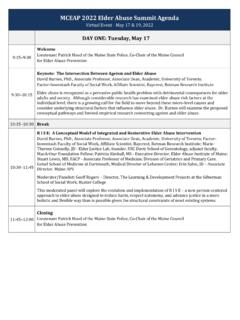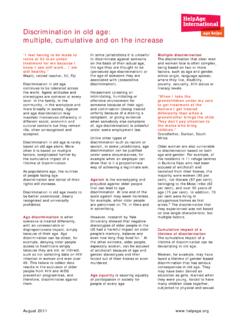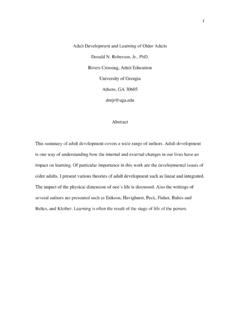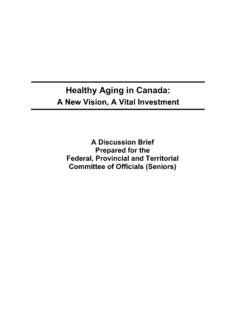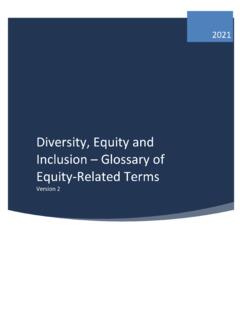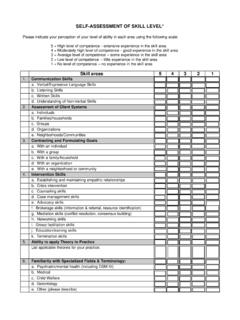Transcription of Understanding Age Stereotypes and Ageism
1 1759 Understanding Age Stereotypes and AgeismAs we learned in Chapter 1, America has a graying population. Presently, seniors (people age 65 and older) make up 13% of the population. By 2030, when the youngest members of the Baby Boomer generation reach retirement age, 19% of all Americans will be seniors ( Census Bureau, 2010). The graying demographics of the population will focus more attention on issues facing older aged Americans. Research on successful aging is particularly applicable here: Successful aging is a con-cept that incorporates freedom from disease and disability, good cognitive and physical functioning, social connections, and productive activities. Data from large national surveys from 1998 to 2004 estimate that fewer than 12% of all older adults are aging successfully (McLaughlin, Connell, Heeringa, Li, & Roberts, 2010).
2 This means that the large majority of older adults face challenges in their older years due to poor health, diminished cognitive ability, social isolation, and boredom. Even though age is one of the primary categories by which we organize our social world (see Chapter 2), the stereotyping and discrimination of older people has received only a fraction of the research attention that has been devoted to the Understanding of race and gender-based prejudice. In this chapter, we explore how stereotyping, prejudice, and discrimi-nation of older adults undermine successful aging. TOPICS COVERED IN THIS CHAPTER: Stereotypes association with older people Age-related discrimination 176 Understanding THE PSYCHOLOGY OF DIVERSITYOld Age Categorization and StereotypingRecall from Chapter 2 that age (along with race and gender) is a primary social cate-gory, meaning that age-based social categorizations are automatic, or made too quickly (under 1 second) to be thoughtful and deliberate (Brewer & Lui, 1989).
3 As with race and gender, we rely on physical cues for categorizing people based on age. What physical characteristics do you associate with older or elderly people? Wrinkled skin, gray or white hair, and posture and movement variables can all assist rapid identifica-tion of people based on their (old) age. The labels we give to these social categories vary but include old people, elders, seniors, senior citizens, and the elderly. Categorization of people into old age groups supports Ageism , which refers to attitudes and beliefs, feelings, and behavior toward people based on their old age. We will con-sider each of these aspects of Ageism in turn. Early research found that there was not a one-size-fits-all stereotype of older peo-ple; rather, people held Stereotypes of subgroups of older people (Brewer, Dull, & Lui, 1981).
4 These subgroups, and the Stereotypes associated with them, were first examined by Daniel Schmidt and Susan Boland (1986). They generated a pool of 99 adjectives and traits that were used in the study by asking people for terms they use when they think about older adults. These traits were then given to participants who were instructed to sort them into groups based on the traits they associated with particular kinds, or subgroups, of older people. Participants trait sorting varied widely; some used as few as two subgroups, while others identified as many as 17 different types of older people. These trait sorts were analyzed via a hierarchical clustering procedure that identifies the best structure of nonoverlapping groups of traits. The analysis in this study found that Stereotypes of older people had three levels general traits, positive versus negative subgroups, and individual traits within each subgroup.
5 At the most superordinate level were traits that described all old people, regardless of their sub-group. These included gray haired, hard of hearing, balding, and poor eyesight; indeed, the only nonphysical trait in the overall stereotype of old people was retired. Participants identified 12 subtypes of older people, eight were negatively valued and four were positively valued. Mary Lee Hummert and her colleagues (1994) replicated Schmidt and Boland s (1986) study with a more age-diverse sample of participants. They found that older-age participants had more, and more varied, Stereotypes of the elderly, whereas younger participants had relatively simple Stereotypes of the elderly. When the findings of the two studies are combined, seven common Stereotypes of old people emerged.
6 Table displays the Stereotypes and their traits. When people evaluate a variety of out-groups along the fundamental dimensions used by the stereotype content model, older people consistently are grouped with dis-abled and developmentally disabled/retarded people. Thus, general Stereotypes of old people reflect low levels of competence and high levels of warmth (Cuddy & Fiske, 2002). Whereas views of the elderly s competence are low but not extremely low, very few groups get higher warmth ratings than the elderly. Accordingly, Stereotypes of the elderly contain more traits that reflect warmth than competence. Amy Cuddy and her colleagues (2005) tested the malleability of the old age stereotype; in other words, does Understanding Age Stereotypes and Ageism 177the warm and incompetent change if older people disconfirm the stereotype in some way?
7 They had participants read a description of an elderly adult that incorporated the warm traits in the elderly stereotype. The description then included further material that manipulated the competence of the person: Participants (randomly determined) read either about the person s poor or excellent memory. After this exercise, partici-pants rated the person on warmth and competence dimensions. Elderly targets who were described as low in competence were given higher warmth ratings compared with the highly competent (and a no competence information control) target. Interestingly, the competence manipulation did not change participants ratings of the elderly tar-get s competence. When the elderly target behaved in a stereotype-consistent manner (by being less competent than expected), participants rewarded the elderly person with higher warmth ratings.
8 Cuddy et al. (2005) concluded that the positive dimension of the old age stereotype is malleable (old people can be more or less warm) but the negative dimension resists change (old people are always incompetent). In an important review, Richard Posthuma and Michael Campion (2009) studied Stereotypes of older people in the workplace by synthesizing findings from over 100 studies of age-related stereotyping at work. Based on their analysis, Stereotypes of older workers have three strong themes. First, they are perceived as less motivated and com-petent at work. This meshes with the stereotype content model s conclusions that older people are viewed as warm but not very competent but in fact, there is little evidence that work performance declines with age (Posthuma & Campion, 2009).
9 Some studies even show that, relative to younger people, older people are more productive at Table Representative Traits in the Stereotypes of Subgroups of Older PeopleSubgroupTraitsDespondentneglected, sad, afraid, lonelySeverely impairedfeeble, slow thinking, senileShrew/curmudgeonill-tempered, complaining, prejudiced, stubborn, nosyReclusequiet, timid, live in past, set in waysJohn Wayne conservativeproud, patriotic, wealthy, conservative, religiousPerfect grandparentkind, generous, family oriented, wiseGolden Agerintelligent, productive, healthy, independentSOURCES: Schmidt, D. F., & Boland, S. M. (1986). Structure of perceptions of older adults: Evidence for multiple Stereotypes . Psychology and Aging, 1(3), 255 260. Hummert, M., Garstka, T., Shaner, J., & Strahm, S. (1994). Stereotypes of the elderly held by young, middle-aged, and elderly adults.
10 Journal of Gerontology: Psychological Sciences, 49, 240 Understanding THE PSYCHOLOGY OF DIVERSITY their jobs. Second, numerous studies show that older employees are also viewed as harder to train or retrain and are thus inherently less valuable as employees. This ste-reotypic assumption may reflect the low-competence stereotype but also reveals assumptions of older employees inability to change, their likely shorter tenure with the company, and less potential for development. Third, older workers are perceived as more expensive employees because they have higher salaries and, due to declining health, use more health care benefits. This piece of the stereotype reflects the wide-spread, though exaggerated, assumption that old age and illness are correlated (Ruppel, Jenkins, Griffin, & Kizer, 2010).










